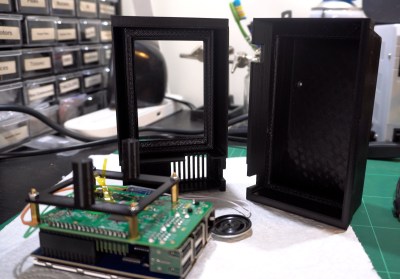It appears that every great console is bound to get a miniature remake: we’ve had the PlayStation Classic, the Mini NES and SNES, and even a miniature Sega Genesis/Mega Drive. But one great console that was sorely missing from that list, at least according to [Brendan], was the Vectrex. So he went ahead and built a fully-functioning miniature Vectrex Console.
If the name “Vectrex” doesn’t ring a bell in your mind, you’re not alone: a commercial failure, it was quickly forgotten by most following the 1983 video game crash. But it has retained a cult status among enthusiasts due to its unique design featuring a monochrome vector monitor, onto which you can place transparent overlays to obtain a sort-of color display. Its games can now all be emulated using software like RetroPie, which is what [Brendan] chose to run on a Raspberry Pi Model 2 that he had lying around.
 As for the display, he settled on a Pi-compatible 3.5″ TFT device. Hooking it up to the Pi was easy enough, but getting the image rendered in its proper portrait orientation was quite a headache, requiring endless fiddling with drivers and configuration files.
As for the display, he settled on a Pi-compatible 3.5″ TFT device. Hooking it up to the Pi was easy enough, but getting the image rendered in its proper portrait orientation was quite a headache, requiring endless fiddling with drivers and configuration files.
Once he got this working, [Brendan] set to work designing a miniature copy of the Vectrex’s original case. It took a few iterations and several 10-hour runs on his 3D printer before he ended up with a sturdy case that securely held the Pi and its display in place. A few more hours of printing later he also had a handheld controller, which he based on an Arduino Pro Mega. The Arduino reads out four regular pushbuttons and a joystick, and communicates with the Pi through a coiled USB cable.
The end result, as you can see in the video embedded below, is the cutest little Vectrex we’ve ever seen. It’s really the opposite of this big-screen Vectrex project. We’ve also seen a Vectrex projector, and even one with a real color monitor hacked in.
















Nice build. Do you want to share your collection of stl files?
Here you go https://www.thingiverse.com/thing:5335050
First and foremost, awesome to see a “minified” Vectrex & a cool project overall, but i kind of wish the guy would try source a small CRT for a version 2 of this :)
^ this
Nice project but I was disapointed not to see any vector monitor in it!
If my memory serves, Vectrex was originally planned with 5″ CRT when Milton Bradley got interested in this system. They wanted bigger screen so they upped the CRT to 9″
Cool story bro, but this isn’t really a Vectrex without the vector.
I’d call it a Rastrex – “ras” for both “rasterized” and “raspberry pi”
Very early on, there were vector display projects. Maybe even the first issue of Byte. There were surplus vector displays, but oscilloscopes were handy.
But it was the early days when anything was considered, and then interest moved elsewhere.
And of course, vector displays were not uncommon in earlier computers. Didn’t graphic displays come to computers as vector displays? A pair of D/A converters and an oscilloscope.
Pretty sure I saw a CRT to Vector conversion quite some time ago too…
manual edit :) :
https://hackaday.com/2014/09/18/building-a-vector-monitor-controller/
I have been tempted to try this, but I will also fully and embarrassingly admit that I am frightened of anything beyond around 12VDC. I’ve changed out a few CRT’s in classic computer terminals and those projects were downright frightening to me.
And then there is “the implosion thing”. You haven’t lived until you’ve cut off the “cataract” (rotten RTV-like rubber) with a heated nichrome wire in order to remove and replace the implosion shield of an irreplaceable CRT.
It is extremely difficult to find “old school” electrostatic tubes beyond the very small (5″) these days. In the 60’s and 70’s, you could find very large electrostatic tubes all over the place (radar and computer surplus) cheaply, many with very long persistence phosphors.
I have seen old articles about turning tv sets into scopes, but they were for very specific uses, so you didn’t need bandwidth.
But there always seemed to be someone selling “plans” in the backs of magazine to turn a tv into a scope. I remember a question to one of the Q&A columns, “do these things work?” And the answer was ” sort of”, you weren’t going to get much out of it.
The controller uses a Arduino Pro Micro, not mega.
Yeah i was just like, a pro /mega/ what on earth is that :D
“Finally” Um, how about mine from 2016 that was probably half the size and done without a RasPi in sight?
https://www.youtube.com/watch?v=wMuRAMrSADI